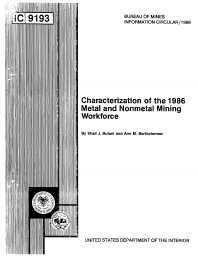Mining Publication: Characterization of the 1986 Metal and Nonmetal Mining Workforce
Original creation date: January 1988
In 1986, the Bureau of Mines conducted a probability sample survey, mining industry population survey, to measure such employee characteristics as occupation; principal equipment operated; work location at the mine; present job, present company, and total mining experience; job-related training during the last 2 yr; age; sex; race; and education. The population estimates are necessary to properly analyze the Mine Safety and Health Administration (MSHA) injury (includes illness and fatality data) statistics; that is, to compare and contrast injury rates for various subpopulations in order to identify those groups that are exhibiting higher than average injury rates. This report uses the survey's results to characterize the U.S. metal and nonmetal mining (includes metal, stone, sand and gravel, and nonmetal industries) workforce from March through September 1986.
Authors: SJ Butani, AM Bartholomew
Information Circular - January 1988
NIOSHTIC2 Number: 10006294
U.S. Department of the Interior, Bureau of Mines, IC 9193, 1988 Jan; :1-55
See Also
- Bleeder System in Virgin Area in a Pittsburgh Coalbed Mine
- Methane Emission from U.S. Coal Mines, A Survey
- Pillar Stability Issues Based on a Survey of Pillar Performance in Underground Limestone Mines
- Possible Impact of New Safety Technology Developments on the Future of the United States Mining Industry
- Reducing Low Back Pain and Disability in Mining
- Research and Development Contract for Coal Mine Communication System: Volume 2 - Mine Visits
- Safety Culture Assessment in Underground Coal Mining
- Selected Health Issues in Mining
- Technique to Assess Hazards in Underground Stone Mines: the Roof Fall Risk Index (RFRI)
- Underground Mine Communications
- Content source: National Institute for Occupational Safety and Health, Mining Program


 ShareCompartir
ShareCompartir
